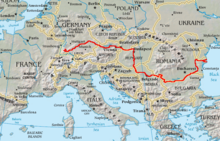
Back Donau Afrikaans Donau ALS ዳኑብ ወንዝ Amharic Río Danubio AN Donua ANG دانوب Arabic نهر الدانوب ARZ ডানয়ুব নদী Assamese Danubiu AST Дануб AV
| Danube | |
|---|---|
 The Danube in Budapest | |
 Course of the Danube, marked in red | |
| Location | |
| Countries | |
| Cities | |
| Physical characteristics | |
| Source | Breg |
| - location | Furtwangen im Schwarzwald, Baden-Württemberg, Germany |
| - coordinates | 48°05′44″N 08°09′18″E / 48.09556°N 8.15500°E |
| - elevation | 1,078 m (3,537 ft) |
| 2nd source | Brigach |
| - location | St. Georgen im Schwarzwald, Baden-Württemberg, Germany |
| - coordinates | 48°06′24″N 08°16′51″E / 48.10667°N 8.28083°E |
| - elevation | 940 m (3,080 ft) |
| Source confluence | |
| - location | Donaueschingen, Baden-Württemberg, Germany |
| - coordinates | 47°57′03″N 08°31′13″E / 47.95083°N 8.52028°E |
| Mouth | Danube Delta |
| - location | Ukraine |
| - coordinates | 45°13′3″N 29°45′41″E / 45.21750°N 29.76139°E |
| Length | 2,850 km (1,770 mi)[1] |
| Basin size | 801,463 km2 (309,447 sq mi) |
| Discharge | |
| - location | Before the Danube Delta |
| - average | (Period: 1931-2010) 6,510 m3/s (230,000 cu ft/s)[2] (Period: 1970-2015) 6,546 m3/s (231,200 cu ft/s)[3] |
| - minimum | 1,790 m3/s (63,000 cu ft/s)[2] |
| - maximum | 15,900 m3/s (560,000 cu ft/s)[2] |
| Discharge | |
| - location | Passau, Bavaria, Germany 30km before town |
| - average | 580 m3/s (20,000 cu ft/s) |
| Discharge | |
| - location | Vienna, Austria |
| - average | 1,900 m3/s (67,000 cu ft/s) |
| Discharge | |
| - location | Budapest, Hungary |
| - average | 2,350 m3/s (83,000 cu ft/s) |
| Discharge | |
| - location | Belgrade, Serbia |
| - average | 5,600 m3/s (200,000 cu ft/s) |
The Danube (Latin name Hister) is the second-longest river in Europe (the Volga is the longest). It is the longest river of the European Union.
The river is 2,860 km (1,777 mi) long. Brigach and Breg join in Donaueschingen (near the Black Forest) to "make" the Danube. The Danube flows through or makes part of the border of 10 countries: Germany, Austria, Slovakia, Hungary, Croatia, Serbia, Romania, Bulgaria, Moldova and Ukraine. The river ends in the Black Sea through the Danube Delta.
Bigger cities include Ulm, Regensburg in Germany; Linz, Vienna in Austria; Bratislava in Slovakia, Budapest in Hungary; Vukovar in Croatia; Novi Sad and Belgrade in Serbia.
The Danube is named in many other languages: Esperanto: Danubo, Bulgarian: Дунав (Dunav), German and Plattdüütsch: Donau, Bavarian: Doana, Greek: Dounavis, Ancient Greek: Ister, Croatian: Dunav, Turkish: Tuna, Latin: Danuvius or Danubius, Romanian: Dunăre, Serbian: Дунав, Slovak: Dunaj, Ukrainian: Dunay.
The Danube is an important waterway. Ocean ships can go to Brăila in Romania. River boats can go to Kehlheim in Bavaria. Smaller ships can travel as far north as Ulm, Germany.
There are three artificial waterways built on the Danube:
- the Danube-Tisa-Danube Canal (DTD) in the Banat and Bačka regions (Vojvodina, in the northern province of Serbia)
- the 64 km Danube-Black Sea Canal, between Cernavodă and Constanţa (Romania) finished in 1984, shortens the distance to the Black Sea by 400 km
- the Rhine-Main-Danube Canal (about 171 km), finished in 1992, linking the North Sea to the Black Sea.
There is much history and culture related to the Danube. As with many other rivers, its natural environment and plants and animals are affected by pollution.
- ↑ "Danube River". Britannica.com.
- ↑ 2.0 2.1 2.2 "The Danube River in the Pontic Sector" (PDF). 2012.
- ↑ "Points of view expressed by the Romanian authorutues and scientific research institute" (PDF).